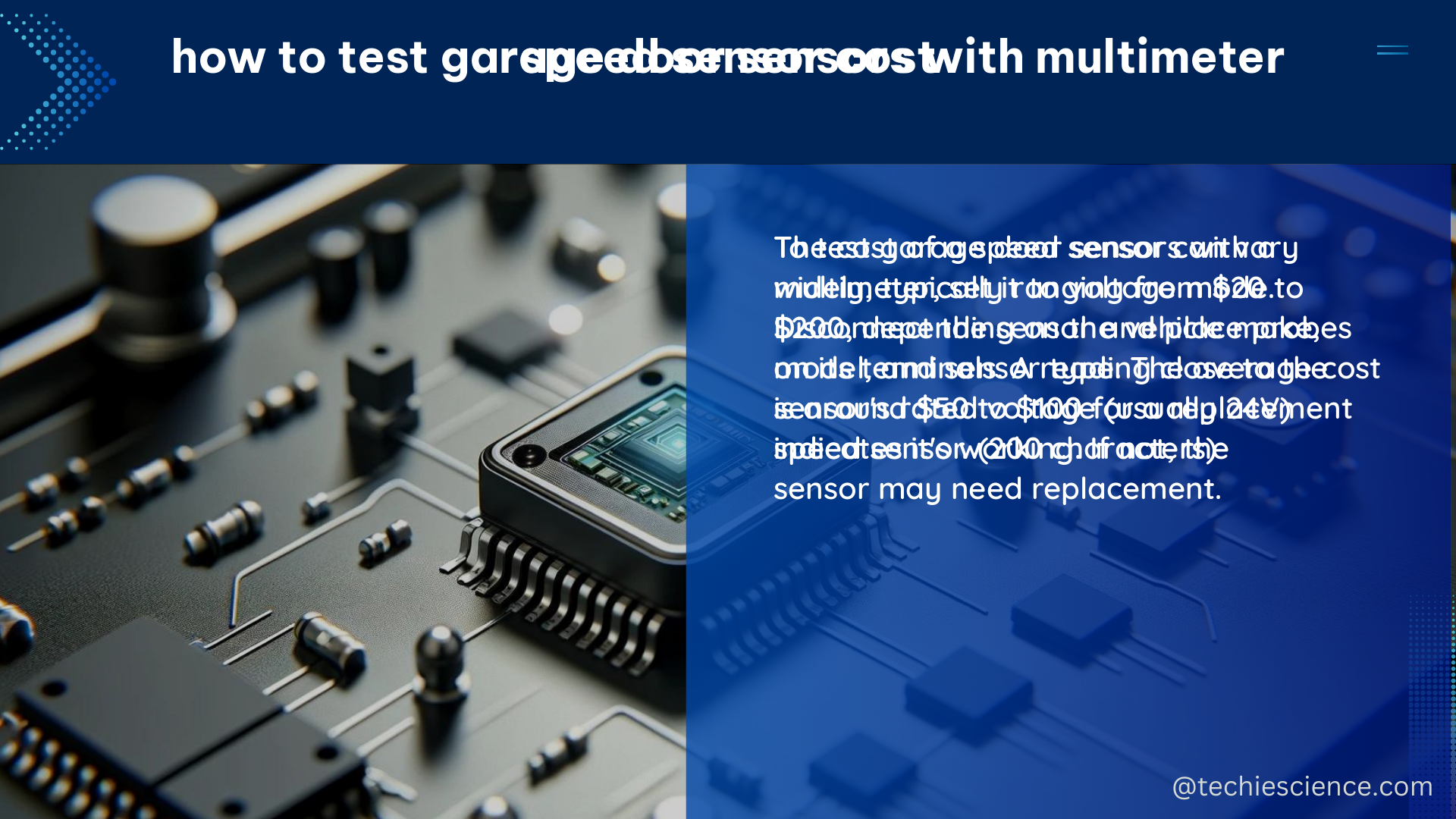The cost of replacing a speed sensor in a vehicle can vary significantly, depending on the make, model, and specific requirements of the car. On average, the total cost for a Vehicle Speed Sensor Replacement ranges from $237 to $280, with labor costs estimated between $132 and $166, and parts priced between $105 and $114. However, the actual cost can be higher or lower, depending on various factors such as the location, the complexity of the replacement process, and the specific parts required for the replacement.
Understanding the Types of Speed Sensors
When it comes to the technical specifications of a speed sensor, it is essential to understand that there are different types of speed sensors, including magnetic, Hall effect, and optical sensors. These sensors typically measure the rotation speed of a shaft or gear and transmit this information to the vehicle’s engine control unit (ECU) or powertrain control module (PCM).
Magnetic Speed Sensors
Magnetic speed sensors are the most common type of speed sensor used in modern vehicles. These sensors use a magnetic field to detect the rotation of a ferromagnetic target, such as a toothed wheel or reluctor ring, and convert this information into an electrical signal.
A typical magnetic speed sensor may have the following specifications:
| Specification | Value |
|---|---|
| Sensor Type | Magnetic |
| Sensor Range | 0-10,000 RPM |
| Operating Temperature Range | -40°C to +125°C |
| Voltage Requirements | 12V power supply, 0-5V signal output |
| Communication Protocol | Analog |
| Physical Dimensions | 20mm diameter, 30mm length, 10g weight |
Hall Effect Speed Sensors
Hall effect speed sensors use a semiconductor device that produces a voltage proportional to the magnetic field applied to it. These sensors are often used in applications where the target wheel or reluctor ring is made of non-ferromagnetic materials, such as aluminum or plastic.
A typical Hall effect speed sensor may have the following specifications:
| Specification | Value |
|---|---|
| Sensor Type | Hall Effect |
| Sensor Range | 0-10,000 RPM |
| Operating Temperature Range | -40°C to +125°C |
| Voltage Requirements | 5-24V power supply, 0-5V signal output |
| Communication Protocol | Digital |
| Physical Dimensions | 15mm diameter, 25mm length, 8g weight |
Optical Speed Sensors
Optical speed sensors use a light source, such as an LED, and a photodetector to detect the rotation of a target wheel or reluctor ring. These sensors are less common in automotive applications but may be used in some high-precision applications or in environments where magnetic interference is a concern.
A typical optical speed sensor may have the following specifications:
| Specification | Value |
|---|---|
| Sensor Type | Optical |
| Sensor Range | 0-20,000 RPM |
| Operating Temperature Range | -40°C to +105°C |
| Voltage Requirements | 5-24V power supply, 0-5V signal output |
| Communication Protocol | Digital |
| Physical Dimensions | 12mm diameter, 20mm length, 6g weight |
The Speed Sensor Replacement Process

Replacing a speed sensor can be a DIY project for those with the necessary skills and tools. The process typically involves the following steps:
- Removing shields, splash guards, or other items that might prevent access to the sensor.
- Disconnecting the vehicle battery after installing a computer memory-saving device.
- Detaching the wiring harness connector from the sensor.
- Removing the retaining bolt or screw and unseating the sensor.
- Installing the new sensor and o-ring.
- Replacing all components and topping off the transmission fluid as necessary.
- Testing the vehicle to verify the repair.
It is important to note that some vehicles may require lifting and supporting the vehicle in the air, which should only be attempted by someone with significant training and experience.
Factors Affecting Speed Sensor Replacement Cost
The cost of a speed sensor replacement can vary significantly depending on several factors, including:
- Vehicle Make and Model: The cost of the replacement parts and labor can vary widely depending on the specific make and model of the vehicle.
- Sensor Type: The type of speed sensor (magnetic, Hall effect, or optical) can also affect the cost, as different sensors may have different complexity and part requirements.
- Location: The cost of labor and parts can vary depending on the geographic location, with prices generally being higher in urban areas or regions with a higher cost of living.
- Complexity of Replacement: Some vehicles may require more complex removal and installation procedures, which can increase the labor costs.
- Specific Parts Required: The cost of the replacement parts can vary depending on the specific make, model, and year of the vehicle, as well as the availability of aftermarket or OEM parts.
Conclusion
The cost of a speed sensor replacement can vary significantly, with an average range of $237 to $280 for the total replacement cost. Understanding the different types of speed sensors and the factors that can affect the replacement cost can help vehicle owners better prepare for and budget for this repair.
References:
– Ford F-150 Vehicle Speed Sensor Replacement Cost – RepairPal.com
– Vehicle Speed Sensor Replacement Cost – CarAdvise
– Dealership cost to diagnose/repair wheel speed sensor – TDIClub.com

The lambdageeks.com Core SME Team is a group of experienced subject matter experts from diverse scientific and technical fields including Physics, Chemistry, Technology,Electronics & Electrical Engineering, Automotive, Mechanical Engineering. Our team collaborates to create high-quality, well-researched articles on a wide range of science and technology topics for the lambdageeks.com website.
All Our Senior SME are having more than 7 Years of experience in the respective fields . They are either Working Industry Professionals or assocaited With different Universities. Refer Our Authors Page to get to know About our Core SMEs.